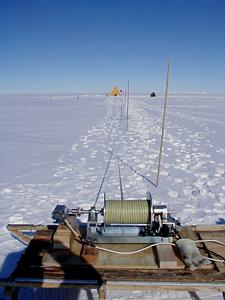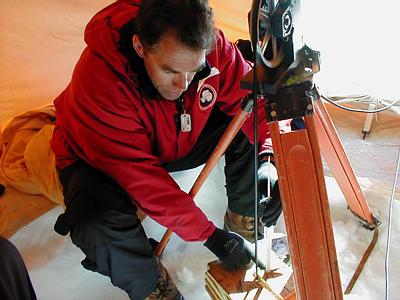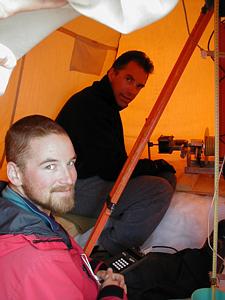8 December, 2000
Ice Dynamics
In order to relate current temperatures in the ice sheet to past climate, Gary Clow needs to know how the ice moves downward over time. The movement of the ice sheet is called ice dynamics. The relative downward motion of the ice is referred to as vertical strain.
Bob Hawley has developed the part of the project that deals with vertical strain in the firn layer. He is investigating movement in this top 70 meters (230ft) of the ice sheet. Bob uses a 100-meter (328ft) borehole near the main drill site. Last year he placed a series of metal bands about every five meters down the borehole. This season and again next year, Bob will be measuring how the depth of the bands has changed. This will yield information about the motion of different parts of the firn layer.
Bob has two methods for measuring the position of the metal bands. One involves using a tuned coil, which is like a metal detector. This device is lowered down the borehole until it detects a metal band. At this point, the precise distance below the top of the borehole casing is measured.
The other method for measuring the position of each metal band employs a video camera. A special camera is lowered down the hole. The position of the bands is determined using the video image along with a measurement from the top of the casing to a mark on the video cable.

This is the setup for what Bob calls a fingerprint log. The top of the borehole is in the Scott tent in the distance. The winch is attached to the video cable. When the winch unwinds, the camera is lowered down the hole at a constant rate of speed. This produces a continuous video of the entire borehole.

Inside the tent, the camera is positioned over the borehole casing.

While Bob monitors the video image, I am using vernier calipers to measure the distance from the borehole casing to a mark on the cable.

Bob is entering data about the position of the tuned coil while I crank the winch. It is about 3000 turns to the bottom. Then you have to wind it back up to the top.
Contact the TEA in the field at
.
If you cannot connect through your browser, copy the
TEA's e-mail address in the "To:" line of
your favorite e-mail package.
|
